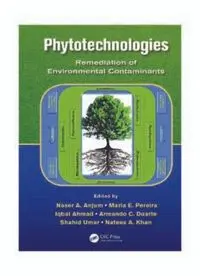
Phytotechnologies: Remediation of Environmental Contaminants PDF
Preview Phytotechnologies: Remediation of Environmental Contaminants
Phytotechnologies Remediation of Environmental Contaminants Phytotechnologies Remediation of Environmental Contaminants Edited by Naser A. Anjum • Maria E. Pereira Iqbal Ahmad • Armando C. Duarte Shahid Umar • Nafees A. Khan Boca Raton London New York CRC Press is an imprint of the Taylor & Francis Group, an informa business CRC Press Taylor & Francis Group 6000 Broken Sound Parkway NW, Suite 300 Boca Raton, FL 33487-2742 © 2013 by Taylor & Francis Group, LLC CRC Press is an imprint of Taylor & Francis Group, an Informa business No claim to original U.S. Government works Version Date: 20120827 International Standard Book Number-13: 978-1-4398-7519-3 (eBook - PDF) This book contains information obtained from authentic and highly regarded sources. Reasonable efforts have been made to publish reliable data and information, but the author and publisher cannot assume responsibility for the valid- ity of all materials or the consequences of their use. The authors and publishers have attempted to trace the copyright holders of all material reproduced in this publication and apologize to copyright holders if permission to publish in this form has not been obtained. If any copyright material has not been acknowledged please write and let us know so we may rectify in any future reprint. Except as permitted under U.S. Copyright Law, no part of this book may be reprinted, reproduced, transmitted, or uti- lized in any form by any electronic, mechanical, or other means, now known or hereafter invented, including photocopy- ing, microfilming, and recording, or in any information storage or retrieval system, without written permission from the publishers. For permission to photocopy or use material electronically from this work, please access www.copyright.com (http:// www.copyright.com/) or contact the Copyright Clearance Center, Inc. (CCC), 222 Rosewood Drive, Danvers, MA 01923, 978-750-8400. CCC is a not-for-profit organization that provides licenses and registration for a variety of users. For organizations that have been granted a photocopy license by the CCC, a separate system of payment has been arranged. Trademark Notice: Product or corporate names may be trademarks or registered trademarks, and are used only for identification and explanation without intent to infringe. Visit the Taylor & Francis Web site at http://www.taylorandfrancis.com and the CRC Press Web site at http://www.crcpress.com Contents Foreword............................................................................................................................................ix Foreword.II........................................................................................................................................xi Preface............................................................................................................................................xvii Contributors.....................................................................................................................................xix Chapter 1 Introduction...................................................................................................................1 Naser A. Anjum, Iqbal Ahmad, Armando C. Duarte, Shahid Umar, Nafees A. Khan, and Maria E. Pereira Section i c ontaminants, contaminated Sites, and Remediation Chapter 2 Heavy.Metals.in.the.Environment:.Current.Status,.Toxic.Effects.on.Plants. and Phytoremediation...................................................................................................7 Mirza Hasanuzzaman and Masayuki Fujita Chapter 3 Phytotechnology—Remediation.of.Inorganic.Contaminants.................................... 75 Felix A. Aisien, Innocent O. Oboh, and Eki T. Aisien Chapter 4 Potential.of.Constructed.Wetland.Phytotechnology.for. Tannery Wastewater Treatment.................................................................................. 83 Cristina S. C. Calheiros, António O. S. S. Rangel, and Paula M. L. Castro Chapter 5 Phytoremediation.of.Petroleum.Hydrocarbon–Contaminated.Soils.in.Venezuela........... 99 Carmen Infante, Ismael Hernández-Valencia, Liliana López, and Marcia Toro Chapter 6 Fate.and.Transport.Issues.Associated.with.Contaminants.and.Contaminant. By-Products.in.Phytotechnology.............................................................................. 113 Chris O. Nwoko Section ii Genus Brassica and contaminants’ Remediation Chapter 7 Metals.and.Metalloids.Accumulation.Variability.in.Brassica.Species:.A.Review..........137 Naser A. Anjum, Sarvajeet S. Gill, Iqbal Ahmad, Armando C. Duarte, Shahid Umar, Nafees A. Khan, and Maria E. Pereira v vi Contents Chapter 8 Oilseed.Brassica napus.and.Phytoremediation.of.Lead.......................................... 151 Muhammad Yasin Ashraf, Nazila Azhar, Khalid Mahmood, Rashid Ahmad, and Ejaz Ahmad Waraich Chapter 9 Potential.for.Metal.Phytoextraction.of.Brassica.Oilseed.Species............................ 179 Guido Fellet, Luca Marchiol, and Giuseppe Zerbi Chapter 10 Phytoremediation.Capacity.of.Brown-.and.Yellow-Seeded.Brassica carinata.......205 Xiang Li, Margaret Y. Gruber, Kevin Falk, and Neil Westcott Chapter 11 Phytoremediation.of.Toxic.Metals.and.the.Involvement.of.Brassica.Species.......... 219 Aryadeep Roychoudhury, Sreeparna Pradhan, Bodhisatwa Chaudhuri, and Kaushik Das Section iii o ther Plant Species and contaminants’ Remediation Chapter 12 Phytoremediation.of.Soils.Contaminated.by.Heavy.Metals,.Metalloids,.and. Radioactive.Materials.Using.Vetiver.Grass,.Chrysopogon zizanioides................... 255 Luu Thai Danh, Paul Truong, Raffaella Mammucari, Yuan Pu, and Neil R. Foster Section iV enhancing contaminants’ Remediation Chapter 13 Effects.of.Biotic.and.Abiotic.Amendments.on.Phytoremediation.Effciency. Applied.to.Metal-Polluted.Soils............................................................................... 283 Erik J. Joner Chapter 14 Phytoremediation:.Strategies.to.Enhance.the.Potential.for.Toxic.Metal. Remediation.of.Brassica.Oilseed.Species................................................................ 293 Mary Varkey, Nand Lal, and Z. H. Khan Chapter 15 Enhanced.Phytoextraction.Using.Brassica.Oilseeds:.Role.of.Chelates...................309 Zhao Zhongqiu and Liu Xiaona Chapter 16 Organic.Acid–Assisted.Phytoremediation.in.Salt.Marshes:.From.Hydroponics. to.Field.Mesocosm.Trials.......................................................................................... 317 M. Caçador, B. Duarte, and J. Freitas Chapter 17 Plant–Microbe.Enabled.Contaminant.Removal.in.the.Rhizosphere........................ 327 L. M. Stout and K. Nüsslein Contents vii Chapter 18 Brassica.Oilseeds–Microbe.Interactions.and.Toxic.Metals.Remediation............... 345 Lixiang Cao Chapter 19 Plant.Growth-Promoting.Bacteria.and.Metals.Phytoremediation............................ 361 Elisa Gamalero and Bernard R. Glick Chapter 20 Plant.Growth.Regulators.and.Improvements.in.Phytoremediation.Process. Effciency:.Studies.on.Metal.Contaminated.Soils.................................................... 377 Meri Barbaferi, Jose R. Peralta-Videa, Francesca Pedron, and Jorge L. Gardea-Torresdey Chapter 21 Remediation.of.Sites.Contaminated.with.Persistent.Organic.Pollutants:. Role of Bacteria........................................................................................................ 391 Ondrej Uhlik, Lucie Musilova, Michal Strejcek, Petra Lovecká, Tomas Macek, and Martina Mackova Chapter 22 Using.Endophytes.to.Enhance.Phytoremediation....................................................407 Zareen Khan and Sharon Doty Chapter 23 Genetically.Modifed.Plants.Designed.for.Phytoremediation.of.Toxic.Organic. and.Inorganic.Contaminants.................................................................................... 415 Tomas Macek, Martina Novakova, Pavel Kotrba, Jitka Viktorova, Petra Lovecká, Jan Fiser, Miroslava Vrbová, Eva Tejklová, Jitka Najmanova, Katerina Demnerova, and Martina Mackova Section V Plants’ contaminants tolerance Chapter 24 Utilization.of.Different.Aspects.Associated.with.Cadmium.Tolerance.in.Plants. to.Compare.Sensitive.and.Bioindicator.Species....................................................... 429 Marisol Castrillo, Beatriz Pernia, Andrea De Sousa, and Rosa Reyes Chapter 25 Analytical.Tools.for.Exploring.Metal.Accumulation.and.Tolerance.in.Plants......... 443 Katarina Vogel-Mikuš, Iztok Arčon, Peter Kump, Primož Pelicon, Marijan Nečemer, Primož Vavpetič, Špela Koren, and Marjana Regvar Chapter 26 Metals.and.Metalloids.Detoxifcation.Mechanisms.in.Plants:.Physiological. and Biochemical.Aspects.......................................................................................... 497 Palaniswamy Thangavel, Ganapathi Sridevi, Naser A. Anjum, Iqbal Ahmad, and Maria E. Pereira viii Contents Chapter 27 Studies.on.Phytoextraction.Processes.and.Some.Plants’.Reactions.to.Uptake. and.Hyperaccumulation.of.Substances..................................................................... 521 Andrew Agbontalor Erakhrumen Chapter 28 Uptake.and.Metabolism.of.Pharmaceuticals.and.Other.Emerging. Contaminants.by.Plants............................................................................................ 541 Benoit van Aken, Rouzbeh Tehrani, and Rashid Kaveh Foreword Environmental.pollution.can.be.considered.as.an.inevitable.evil.of.human.evolution-led.immense. scientifc.and.technological.progress,.which.has.now.become.one.of.the.most.critical.challenges.fac- ing.the.world.today..Although.the.pollution.level.of.the.biosphere.is.rapidly.going.from.bad.to.worse,. there.is.still.a.dearth.of.sustainable.strategies.to.resolve.varied.devastating.environmental.issues.. From.this.important.perspective,.a.variety.of.plant-.and.associated.microbe-based.technolo.gies—. col.lectively.termed.phytotechnologies—are.now.widely.accepted.as.a.nature-driven.mighty.biogeo- chemical.process.for.cleaning.environmental.compartments.contaminated.with.varied.pollutants..In. fact,.the.term.itself.describes.the.application.of.science.and.engineering.to.examine.problems.and. provide.solutions.involving.plants.and.their.associates;.thus,.it.is.aimed.at.providing.benefcial.vital. roles.within.both.societal.and.natural.systems.to.improve.environmental.and.human.health. Moreover,.it.is.an.emerging.technology.that.has.the.potential.to.treat.a.wide.range.of.contam- inants. at. lower. cost. than. traditional. technologies.. This. technology. uses. various. types. of. plants. and. plant. products. to. degrade,. extract,. contain,. or. immobilize. contaminants. in. soil. and. water.. Phytotechnology. has. been. used. for. remediation. of. chlorinated. solvents,. metals,. explosives. and. propellants,.pesticides,.polycyclic.aromatic.hydrocarbons,.radionuclides,.and.petroleum.hydrocar- bon.compounds..While.phytotechnologies.generally.are.applied.in situ,.ex situ.applications.(e.g.,. hydroponics.systems).are.possible..Typical.organic.contaminants,.such.as.petroleum.hydrocarbons,. gas.condensates,.crude.oil,.chlorinated.compounds,.pesticides,.and.explosive.compounds,.can.be. addressed.using.plant-based.methods..Phytotechnologies.also.can.be.applied.to.typical.inorganic. contaminants,.such.as.heavy.metals,.metalloids,.radioactive.materials,.and.salts..Additionally,.phy- totechnologies. provide. numerous. advantages. for. supporting. sustainable. water. quality. sanitation. and environmental. conservation,. but. the. studies. and. application. of. phytotechnologies. for. water. sanitation.and.conservation.are. still. limited,.particularly. in.Asian.countries..Hence,.more.effort. should.be.undertaken.to.explore.scientifc.information.and.the.use.of.this.technology..Furthermore,. some.phytotechnology.applications.involving.plants.for.housing,.food,.forage,.and.sources.of.medi- cine.can.create.employment..This.is.particularly.important.in.developing.countries. Researchers.Drs..Naser.A..Anjum,.Maria.E..Pereira,.Iqbal.Ahmad,.Armando.C..Duarte.(CESAM- Centre. for. Environmental. and. Marine. Studies. and. the. Department. of. Chemistry,. University. of. Aveiro,.Portugal),.Dr..Shahid.Umar.(Hamdard.University,.New.Delhi,.India),.and.Dr..Nafees.A.. Khan.(Aligarh.Muslim.University,.Aligarh,.India).have.done.a.timely.admirable.job.of.assembling. a.wealth.of.information.on.this.sustainable.environmental.contaminants.remediation.technology.in. a.single.volume..As.the.current.volume.has.successfully.provided.a.common.platform.to.a.broad. range.of.experts.including.environmental.engineers,.environmental.microbiologists,.chemical.sci- entists,. and. plant. physiologists/molecular. biologists. working. with. a. common. aim. of. sustainable. solutions.to.varied.environmental.issues,.I.fervently.believe.that.this.volume.will.be.a.meaningful. addition.to.the.existing.body.of.knowledge.that.is.essential.to.develop.good.management.practices. in.this.feld.and.for.sure.will.also.enlighten.readers.of.various.disciplines.and.at.various.levels,.thus. bridging.theoretical.knowledge.to.application. M. N. V. Prasad Professor, Recipient of Pitamber Pant National Environment Fellowship of the Ministry of Environment and Forests, Government of India Department of Plant Sciences, University of Hyderabad Andhra Pradesh, India ix
